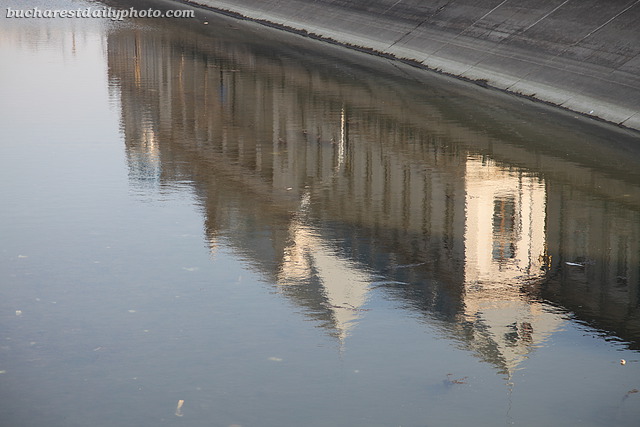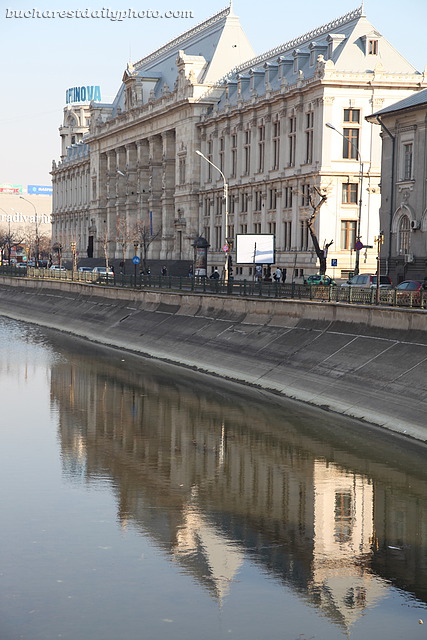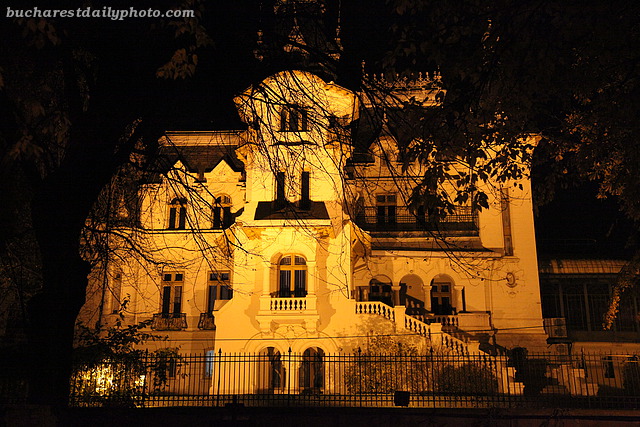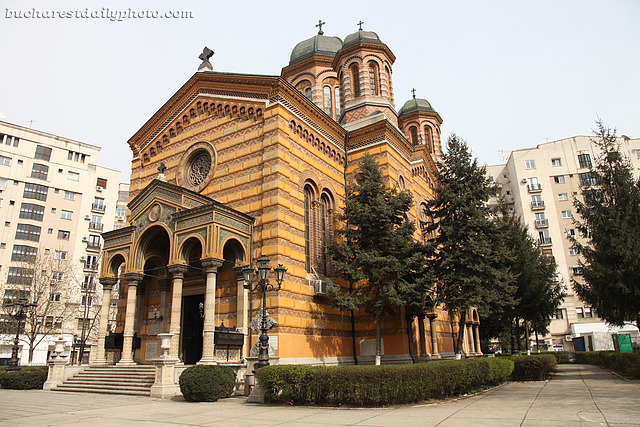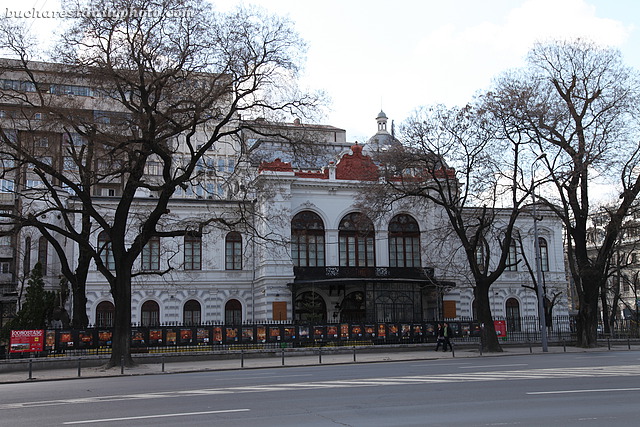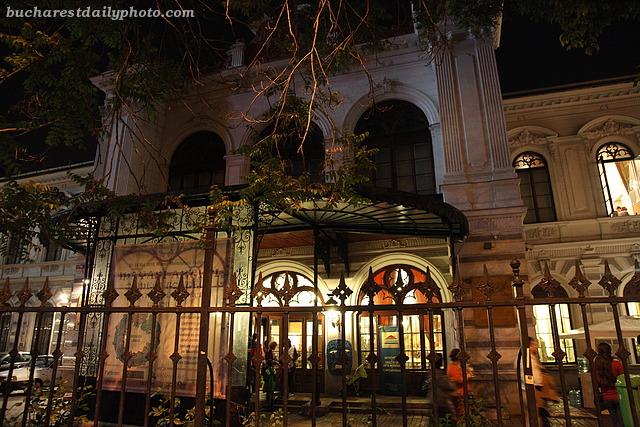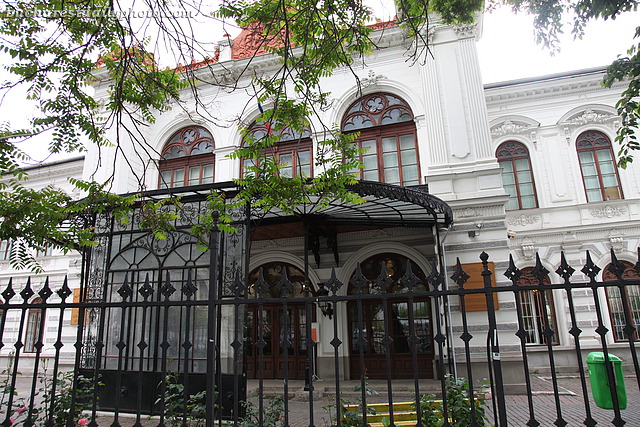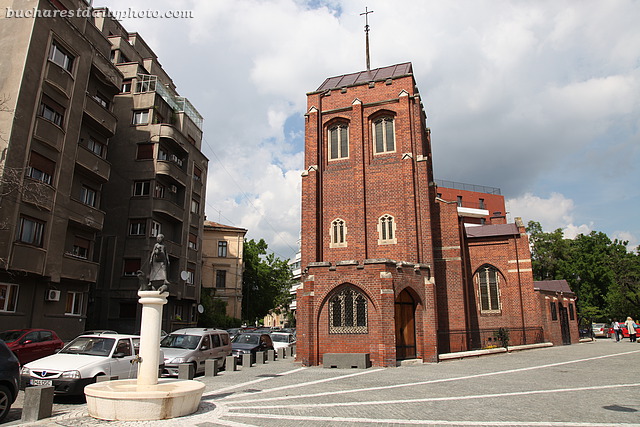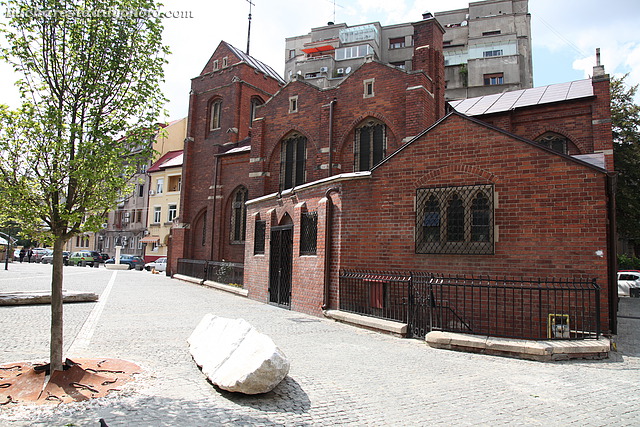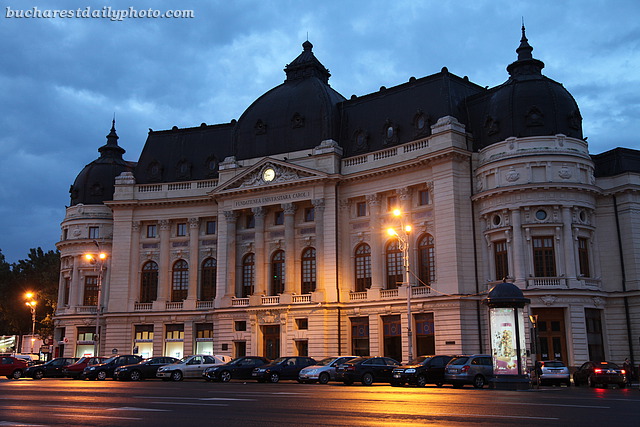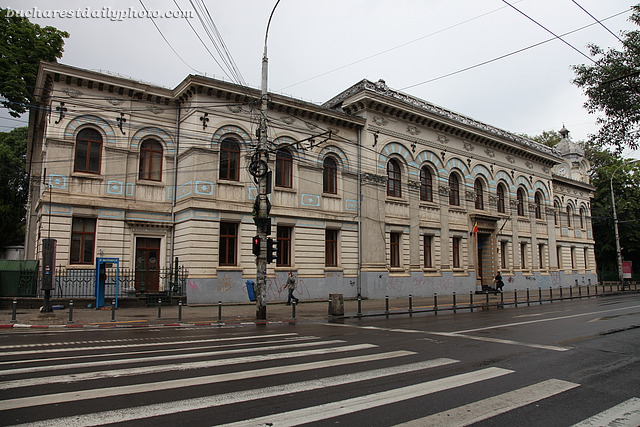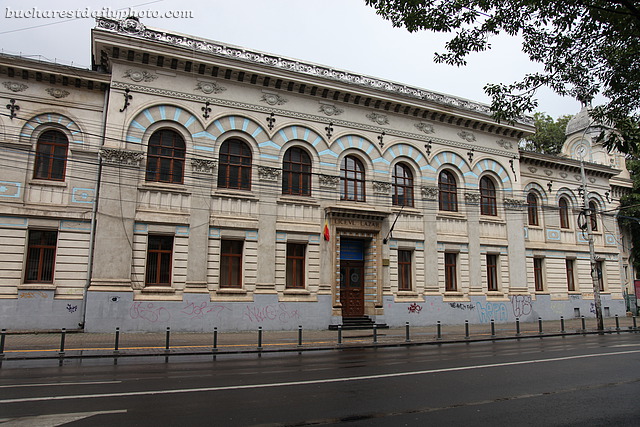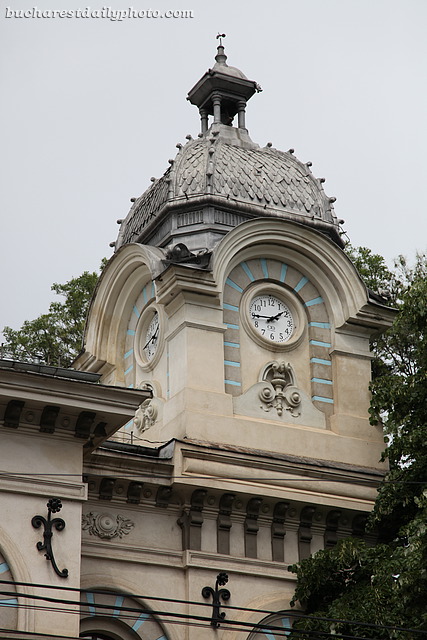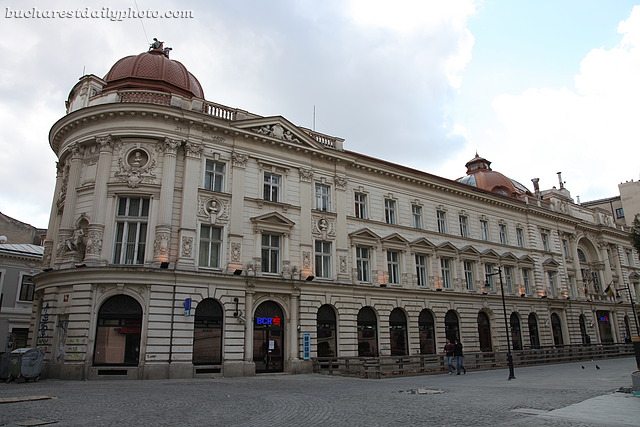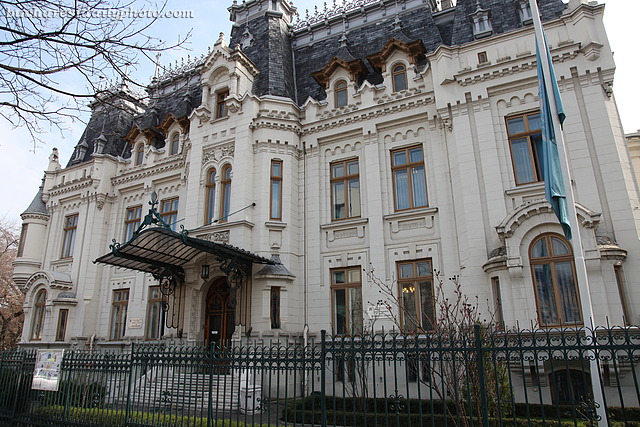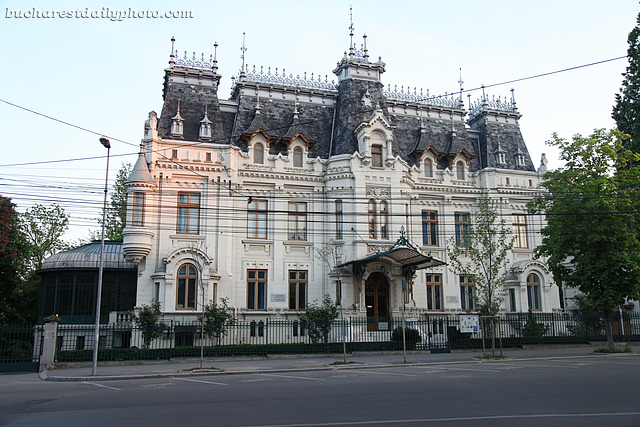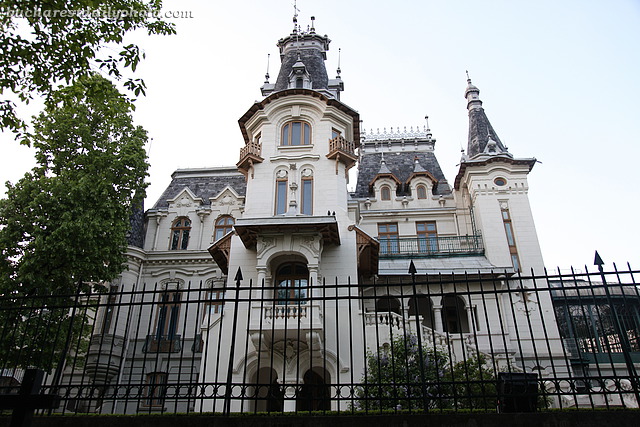Palace of Justice
And if we linger a little bit more in Cişmigiu Park, waiting for the dark, we can catch a glimpse of the lighted back of Kretzulescu Palace.
Most of Bucharest’s old churches have a history full of drama: fires, earthquakes, demolitions, temporary closings. But even among these tumultuous histories, the Princess Bălașa Church (Biserica Domnița Bălașa in Romanian) must hold some kind of a record in terms of fighting natural disasters. The first church on this spot was a wooden one built in 1773-1774 by Princess Bălașa (Constantin Brâncoveanu‘s sixth daughter) and her husband Manolache Lambrino. This first church burned down and was replaced in 1751 by a stone structure built by Princess Bălașa after the death of her husband. Renovated in 1831, the second church didn’t last too long either being damaged during an earthquake in 1838. It was replaced by a third church built in 1838-1842 by Safta Brâncoveanu. At its turn, the third structure was damaged by floods and was replaced by a fourth one built between 1881-1885. This is the striped building that we see today, designed by architect Alexandru Orăscu in a Neo-Romanian, Neo-Byzantine style. The current church had to be repaired again after each of the two major 20C earthquakes (1940 and 1977). Princess Bălașa Church is one of the most popular places for weddings in Bucharest and if you come here on a Saturday or Sunday you are almost certain to see a wedding taking place. The church is located off the Union Square, facing the side of the Palace of Justice.
This is another shot of the Museum of the City of Bucharest, this time showing the whole building. I took the photo back at the beginning of April when the trees were still bare.
These two shots show the mansion that houses the Museum of the City of Bucharest which is located in the University Square. The building is also known as Suţu Palace after the name of its builder, Costache Suţu. It was raised in 1833-1835 following the plans of Viennese architects Conrad Schwink and Johann Veit. The style of the building is considered to be neo-gothic. The palace was inherited by Costache Suţu’s son, Grigore Suţu, which together with his wife Irina, hosted many balls, receptions and dances at the palace, attracting Bucharest’s high society. After their death the palace was passed on, hosting first the headquarters of the Chrissoveloni Bank and later the offices of Romania’s National Savings Bank. In 1959 it became the Museum of History of the City of Bucharest.
Today’s photographs show Bucharest’s Anglican Church of the Resurrection, located near Icoanei Park, at the intersection of three streets. Like many other churches in Bucharest, it has an interesting past. It was built in 1913-1914 on land given to the British Crown by the city of Bucharest. It was opened in 1920 and dedicated in 1922 by the Bishop of Gibraltar. In the early days the church was regularly attended by the Queen Marie of Romania, granddaughter of Queen Victoria, and it was due to her help that the building was completed. The church was closed during WWII from 1940 to Christmas Day 1944, a period when it was under the care of a church guardian and cleaner, also named Maria, who continued to work at the church until 1983 when at the age of 78 was forced to retire. She was later presented with the bronze cross of the Order of St. Augustine of Canterbury by the Archbishop of Canterbury. After the communists took power the church had no permanent chaplain, being served monthly by visiting priests. This situation lasted until 1966. The church’s official webpage describes the harsh conditions of the late 1980s when the church was under constant surveillance and how “the few Romanians who dared to step inside risked losing their job, their home, even their freedom”. These days the church offers English language services every Sunday. The building’s red brick facade is reminiscent of British architecture, and is the work of architect Victor Gh. Ştephănescu.
Gheorghe Lazăr High School is Bucharest’s second oldest high school, being opened in 1860. It is named after Gheorghe Lazăr, a Transylvanian-born Romanian scholar who founded the first Romanian language school in Bucharest in 1818 and whose statue was featured on this blog last January. The high school is one of the most famous in Bucharest and its location at the southeast corner of Cişmigiu park is unbeatable: what better place to go to when you’re skipping classes? 🙂
Today’s photograph shows a bank building on Lipscani, facing the National Bank of Romania. The books on the architecture of Bucharest that I consulted list it as being built in 1910 – 1913, but sources I found on the web say the building was most probably built before 1900. The architect is unknown. The building served as the headquarters of the General Romanian Bank, which was a branch of Gesselschaft and Bleichröder Bank (thanks to Bucharestian for this information). It was restored during the communist regime in 1983-1984 and for a while served as a shopping mall. I remember buying shoes there once. Today it’s being used as a bank again.
The beautiful palace which is the subject of today’s photo was built in 1902-1906 as a residence for Elena Kretzulescu (aka Elena Creţulescu) by architect Petre Antonescu (1873-1965). It replaced the old family house, which was built around 1718. The palace’s facade is aligned with Ştirbei Vodă Street while the back looms over Cişmigiu Park from a small hill. Purchased in 1927 by city hall, the building was used for various purposes: from 1928-1929 it housed the office of the Prime Minister, followed by the Museum of Religious Art which was closed in 1946 when the communists came to power. Since 1972 the palace has been the seat of UNESCO European Centre for Higher Education. As with many other palaces in Bucharest the architectural style is Eclectic with touches of French Renaissance, which was very much in fashion in Bucharest at the end the 19th century.
The back of the palace seen from Cişmigiu park:
